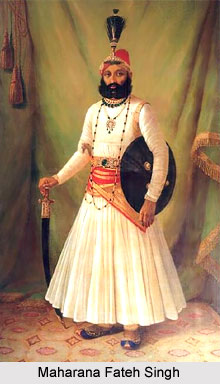 Maharana Fateh Singh was one of the most prominent rulers of the princely state of Mewar, under the British East India Company. At present, Mewar, also known as Udaipur Kingdom, is located in the south central state of Rajasthan state in western part of the country. The Maharana of Mewar reigned over the region for a period of forty six years, from the year 1884 to 1930, when he died. Udaipur served as the capital of the princely state of Mewar and Fateh Singh resided in the City Palace, situated in Udaipur. Maharana Fateh Singh of Mewar was born on 16th December 1849 on Shivrati to father Maharaja Dal Singh, who belonged to the Shivrati branch of Mewar dynasty. He was a progeny of the 4th son Arjun Singh of the Rana Sangram Singh II. First Fateh Singh was adopted by Gaj Singh, who was his elder brother as he had no heir. Consequently he was adopted by Maharana Sajjan Singh of Udaipur, as he also had no heir ether. Thus eventually, Fateh Singh ascended the gadi or throne and became the ruler or Maharaja of Udaipur in the year 1884.
Maharana Fateh Singh was one of the most prominent rulers of the princely state of Mewar, under the British East India Company. At present, Mewar, also known as Udaipur Kingdom, is located in the south central state of Rajasthan state in western part of the country. The Maharana of Mewar reigned over the region for a period of forty six years, from the year 1884 to 1930, when he died. Udaipur served as the capital of the princely state of Mewar and Fateh Singh resided in the City Palace, situated in Udaipur. Maharana Fateh Singh of Mewar was born on 16th December 1849 on Shivrati to father Maharaja Dal Singh, who belonged to the Shivrati branch of Mewar dynasty. He was a progeny of the 4th son Arjun Singh of the Rana Sangram Singh II. First Fateh Singh was adopted by Gaj Singh, who was his elder brother as he had no heir. Consequently he was adopted by Maharana Sajjan Singh of Udaipur, as he also had no heir ether. Thus eventually, Fateh Singh ascended the gadi or throne and became the ruler or Maharaja of Udaipur in the year 1884.
In the year 1887, he was honoured by the British East India Company being appointed as a Knight Grand Commander of the Order of the Star of India (GCSI).
Rule of Fateh Singh
During his reign in Mewar, Maharana Fateh Singh re-constructed the Connaught Dam on Lake Dewali in the year 1889. The artificial lake was originally built by Maharana Jai Singh in 1687, which was washed away by floods two hundred years later. Thus it was re-established by Maharana Fateh Singh to mark the visit of the son of Queen Victoria, Prince Arthur, the Duke of Connaught and Strathearn. The Duke of Connaught laid the foundation stone for the re-construction. Later the lake was enlarged and was renamed as Fateh Sagar Lake. He was the only Indian Prince who did not attend the renowned Delhi Durbar, in both 1903 and 1911.
In the year 1921, when the son of Queen Mary, Edward VIII or Edward Albert Christian George Andrew Patrick David, the Prince of Wales and the Duke of Windsor, visited Udaipur, Maharana Fateh Singh of Mewar refused to welcome him due to illness. His son eventually received the Duke of Windsor. Thus his position in the British Indian Empire was at odds. Afterwards, as a result of ignoring a social unrest in the princely state of Mewar, the powers of Maharana Fateh Singh were reduced and he was officially deposed. Even though he was permitted to hold his supposed title, but the effectual power was transferred to Bhupal Singh, his son and heir.
Personal Life of Fateh Singh
Maharana Fateh Singh was firstly married to Rani Phool Kumari in the year 1867. She was the daughter of the Thakur of Khod in Marwar and died in 1877. Later he was married to the daughter of Thakur Chanda Kol Singh of Varsoda in 1878. The royal couple had a son and two daughters, namely Bhupal Singh, Ankaran Bai and Kishor Kunwar.
Singh died on May 24, 1930 at Udaipur. His son Bhupal Singh succeeded him and became the next Maharana of the princely state of Mewar.



















